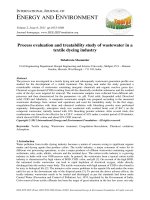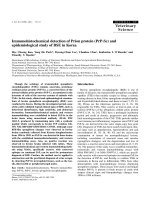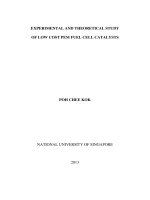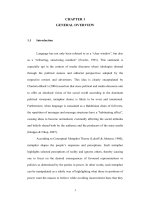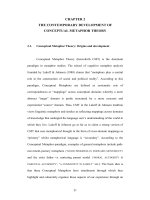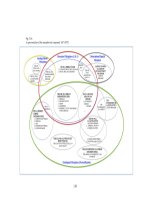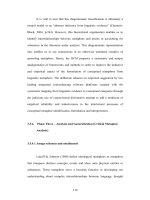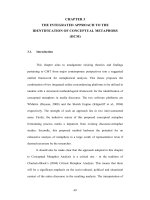Morphology and invitro study of chemicals, plant extracts, bio-agents against Pestalotiopsis mangiferae, causing grey leaf spot of mango in Manipur, India
Bạn đang xem bản rút gọn của tài liệu. Xem và tải ngay bản đầy đủ của tài liệu tại đây (657.92 KB, 12 trang )
Int.J.Curr.Microbiol.App.Sci (2020) 9(5): 2411-2422
International Journal of Current Microbiology and Applied Sciences
ISSN: 2319-7706 Volume 9 Number 5 (2020)
Journal homepage:
Original Research Article
/>
Morphology and invitro Study of Chemicals, Plant Extracts,
Bio-Agents against Pestalotiopsis mangiferae, Causing
Grey Leaf Spot of Mango in Manipur, India
Ch. Inao Khaba*, Marjit Chandam, N. Ajitkumar Singh,
Ch. Premabati Devi and Bireswar Sinha
Department of Plant Pathology, College of Agriculture,
CAU, Lamphelpat-795004, Manipur, India
*Corresponding author
ABSTRACT
Keywords
Morphology,
Antagonists, Plant
extracts, Chemicals,
P. mangiferae,
Mango
Article Info
Accepted:
18 April 2020
Available Online:
10 May 2020
A study was conducted in vitro condition to analyse the morphology and efficacy of bio agent, plant
extract and some chemical against P. mangiferae that were collected from different districts of
Manipur. The morphological character under study consists of colony and conidial characteristics
such as colour, shape, size and appendages. The cultural growth colour of P. mangiferae on PDA
differed from concolour to versicolour fuliginous. The conidial shape varied from oval and spherical
to elliptical with prominent appendages. The conidial length and width were 22.9 and 5.7 µm
respectively. The diseased sample which was collected from different district of Manipur consists of
three septation and the number of conidial appendages was found 2-3 numbers. Among seven
antagonists namely Penicillium citrinum, Trichoderma atroviride, T. ovalisporum, Hypocrealixii, T.
harzianum (69 & 131) and T. asperellum evaluated in vitro, T. asperellum revealed the best in
inhibiting the growth of the fungus (85.8%). Among three plant extracts viz. garlic, neem and sweet
flag evaluated in vitro, garlic extract (3.0%) showed the best result (100.0%). Among the seven
chemicals viz. carbendazim, thiophenate methyl, mancozeb, imidacloprid, fipronil, profenophos and
thiomethoxam evaluated in vitro, thiophenate methyl (0.05%) and carbendazim (0.05%) showed the
best result with 100.0 per cent inhibition in fungal growth.
Introduction
Mangifera indica (Anacardiaceae) is one of
the important fruit tree which is grown
commercially both in tropical and subtropical
region. Mango is known as king of fruits and
it’s a National fruit of India. The genus
Mangifera originated in South-East Asia at an
early date. Records suggest that it has been in
cultivation in the Indian subcontinent for well
over 4000 years now (De Candolle, 1904) and
has been, since time immemorial, one of the
most favourite of the kings and common
people among fruits because of its delicious
taste and fascinated flavour. According to
Mukherjee (1958), the natural spread of genus
is limited to the Indo-Malaysian region,
extending from India to the Philippines and
New Guinea in the east. India is the largest
producer and contributing 40.75% of the total
2411
Int.J.Curr.Microbiol.App.Sci (2020) 9(5): 2411-2422
fruit production with 19.69 million tonnes
production and 8.7 million tonnes/ha
productivity (NHB, 2017). In India, the
important states of mango producing viz.
Andhra Pradesh, Bihar, Gujarat, Maharashtra,
Odisha, Tamil Nadu, Karnataka, Uttar
Pradesh and West Bengal. Apart from India,
the other major producers of mango in the
world are Brazil, Pakistan, Mexico, Indonesia,
the Philippines, Haiti, China and Tanzania.
Mango is also grown to a small extent in
Egypt, Madagascar, Zaire, Venezuela and Sri
Lanka. The climate condition of Manipur is
well suited for growing of Mango.
Young and unripe mango, due to their acidic
taste, are used for culinary purposes as well as
for preparing pickles, chutneys and amchoor.
Ripe fruits are used in preparing of squash,
nectar, jam, cereal flakes, custard powder and
baby food, mango leather (am-paper) and
toffee. Moreover, fruits of some cultivars like
Alphonso and Dashehari are sliced and
canned for catering during the off-season.
Alphonso was found to be the most suitable
for canned juice preparation due to its very
good colour, Consistency and flavor, followed
by Padiri (Gowdaand Ramanjaneya, 1995).
The finest cultivars for processing were
Haden, Haden 2H. Glenn, Joe Welch and
Torbet, which had very good organoleptic
characteristics (Donadio, 1995). High
carotenoi content in Amrapali gives it
potential for juice production and blending
(Khurdiya and Roy, 1989).
The limiting factor in fruit yield is due to the
occurrence of diseases. The pathogen
(P.mangifera) causes infection on leaf, twigs
and panicle. As a result the vegetative growth
and the fruit production of young mango
plants were reduced. In Manipur, grey spot of
mango was first observed by Iboton &
Tombisana (2012) and little work on this
disease was done by Indira (2014).
Materials and Methods
Surveys were conducted during September to
November, 2017 on grey leaf spot of mango
at different locations in the valley districts of
Manipur namely Imphal East, Imphal West,
Thoubal and Bishnupur (Plate 2). The
diseased samples were brought to laboratory
for isolation. The diseased samples were cut
into small pieces of 2-3mm size.
These pieces were surface sterilized with 1%
sodium hypochlorite solution for 2-3 minutes.
The sterilized pieces were then inoculated on
PDA Petri dish. The inoculated Petri plates
were incubated at 28 ± 10C for 4 days. Daily
observations were taken on the development
of the pathogens. The fungal culture was
purified by adopting hyphal tip cut method
from the activity growing hyphal tips.
The pure culture was maintained on freshly
prepared Potato Dextrose Agar slants inside
the refrigerator and periodically sub cultured
to fresh medium during the experimental
period. Pathogenicity test was conducted by
the method described by Koch (1876).
Per cent inhibition on growth was calculated
which was described by Vincent (1927). The
antagonistic activities was recorded by
following dual culture technique using
modified Bell’s scale described by Bell et al.,
(1982) using PDA as basal medium.
Results and Discussion
The grey leaf spot of mango was found at
various mango growing locations in different
valley districts of Manipur (Table 1). Survey
results indicated that there is prevalence of
grey leaf spot of mango (plate 1) in Manipur,
Rattan (2009) reported that grey blight of
mango caused by P.mangiferae (P. Henn.)
Stey is prevalent in many states in India.
2412
Int.J.Curr.Microbiol.App.Sci (2020) 9(5): 2411-2422
Morphological study
P.mangiferae was consistently isolated from
the diseased samples of grey leaf spot of
mango. The present findings is in agreement
with those of Ko et al., (2007) who reported
that single conidial isolates of the fungus were
identified morphologically as P. mangiferae
and were consistently isolated from the
diseased mango leaves on PDA medium.
Similarly, Keith and Zee (2010) who reported
that Pestalotiopsis, Colletotrichum, Mucur
and Guignardia were the agents of leaf spot
of guava in Hawaii (Table 2 and Plate 2).
The conidial size of P. mangiferae ranged
from 22.4-24.8 µm in length and 5.8-6.7 µm
in width. The numbers of conidial appendages
were found to be 2-3 in number. Cultural
growth colour of P. mangiferae on PDA
varied from concolour to versicolour
fuliginous with varied shape such as oval and
spherical to elliptical with prominent
appendages. There was three septation in all
the conidia collected from different places.
Germ tube of the conidia at 8 hours ranged
from 5.5-7.0 µm, at 16 hours, 41.0-43.0 µm
and at 24 hours, 47.0-49.0 µm during
incubation. The present finding is in
agreement with the finding of S.K Singh
(2011) who reported that Pestalotiopsis
isolates were recorded with minor variations
and homogenous conidial lengths (22.2 to
27.1 µm), conidial width (5.5 to 6.9µm) and
size of appendages (4.0 to 6.7 µm). However,
three types of median colour cells were
recorded among the isolates. Ranjana das et
al., (2010) reported that the germination of
spores started at 8 hours of incubation and
gradually increased
upto
20
hours
(maximum).
Pathogenecity test
The fungus isolated from the diseased
samples was found pathogenic when
artificially inoculated on healthy excised
leaves of mango could induced disease
symptom after 7 days of incubation. On
reisolation the same pathogen was found and
thus proved pathogenecity of the pathogen
(plate 3 & 4). The present findings is in
agreement with the findings of Ko et al.,
(2007) who reported that upon conducting
pathogenecity tests, the symptoms of grey leaf
spot were observed on all inoculated leaves,
while
uninoculated
leaves
remained
completely free from symptoms. Reisolation
from the inoculated leaves consistently
yielded P. mangiferae.
Efficacy of chemicals
The linear growth of P.mangiferaewas
completely inhibited by carbendazim (0.1 &
0.05%), thiophanate methyl (0.1 & 0.05%),
and mancozeb at 0.1%. However, mancozeb
(0.05%), Imidacloprid (0.1%), Fipronil
(0.2%),
Profenophos
(0.1%)
and
Thiomethoxam (0.1 & 0.05%) showed 61.53,
35.23, 11.70, 88.33 and (43.43 & 17.57) %
inhibition over control respectively. Fipronil
(0.2%) showed the least inhibition of 11.70%
on linear growth of the pathogen. The fungus
failed to sporurate in all the fungicides tested.
The inhibitory effect of thiophanate methyl
and mancozeb on growth of fungus might be
due to inhibition of nucleic acid synthesis,
melanin synthesis and disrupting lipid
metabolism while inhibitory effect of
carbendazim might be due to disruption of
enzyme synthesis, interfere with nuclear
division of fungus. The present findings are in
agreement with those of Kudalkar et al.,
(1991) who reported that growth and
sporulation of P. mangiferae was completely
inhibited in vitro by carbendazim (100300ppm). Mancozeb also inhibited growth by
78-86%. Similar findings were also reported
by Selvan et al., (1993) that Pestalotiopsis
palmarum was completely inhibited under in
vitro by Carbendazim and Thiophanate
2413
Int.J.Curr.Microbiol.App.Sci (2020) 9(5): 2411-2422
methyl at all concentrations tested. And also
according to Rahman et al., (2013) who
evaluated the efficacy of some selected
contact, systemic and mixed fungicides
against Pestalotia palmarum causal organism
of grey spot of coconut (Table 3 and Plate 5).
Antifungal properties of aqueous plant
extracts
ajoene (Table 4). The aqueous plant extracts
under in vitro revealed that higher doses were
relatively more efficient than the lower doses.
The present findings are in agreement with
the findings of Islam et al., (2004) who
reported that among the plant extracts tested
in vitro, garlic @3% was most effective in
inhibiting 100% radial growth of P.
mangiferae (Plate 6).
Three plant extracts tested against mycelial
growth of P. mangiferae, garlic extract (3 &
1.5%), neem extract (10 & 5%) and sweet
flag extract (10 & 5%) could inhibit (100 &
77.76%), (82.35 & 67.05%) and (83.52 &
61.17%) respectively. The effectiveness of
garlic is might be due to antifungal activity of
Diallyl-disuphide, Diallyl-trisulphide and
Similarly, Saha et al., (2005) reported the
antifungal properties of ethanol and aqueous
extracts of Allium sativum (L.), Daturametel
(L.), Dryopterisfilix-mas (L.) Schott, Zingiber
officinale (Rosc.), Smilax zeylanica (L.),
Azadirachtaindica, (A.) joss. And Curcuma
longa (L.) on Pestalotiopsistheae (Saw.) and
shown 100% inhibition of spore germination.
Table.1 Survey of grey leaf spot of mango in Manipur
Place of Survey
Site/Place
SL.No District
GPS: LOCATION
Latitude
Longitude
1
2
3
4
5
6
7
Imphal East
Imphal East
Imphal East
Bishnupur
Bishnupur
Bishnupur
Bishnupur
Andro KVK
Thayong
AndroMaringthel
Nambol
Ningthou-khong bazaar
Potsangbam
Utlou
24°45.885
24°47.828
24°44.289
24°43.190
24°34.249
24°35.809
24°43.286
094°03.274
094°04.583
094°01.097
094°50.153
094°45.829
094°45.940
094°51.538
Altitude
(ft.)
2649
2666
3335
2537
2510
2560
2538
8
9
10
11
12
Thoubal
Thoubal
Thoubal
Thoubal
Imphal West
24°40.326
24°29.791
24°31.381
24°33.256
24°37.683
094°57.452
094°00.085
094°56.107
094°54.012
094°53.532
2526
2507
2498
2514
2489
13
Imphal West
24°43.698
094°54.372
2518
14
15
Imphal West
Imphal West
Waithou
Kakchingsumangleikai
Wabagaimakhaleikai
Sekmaijingmakhaleikai
Mayang
Imphal
thanaawangleikai
Hiyangthang
mamang
leikai
Iroisemba
ICAR Lamphelpat
24°45.161
24°49.651
094°02.606
094°55.603
2746
2538
2414
Int.J.Curr.Microbiol.App.Sci (2020) 9(5): 2411-2422
Table.2 Morphological study of different isolates of P. mangiferae
Isolate of
P. mangiferae
*Conidial
length(µm)
*Conidialw
idth(µm)
Type of median
colour
Shape
6.8±0.9
Number
of
apical
appendages
(ranges)
2-3
1. AndroKvk
22.8±1.0
Concolour
24.8±0.6
6.3±0.9
2-3
Versicolour
Fuliginous
3. AndroMaringthel
23.5±1.0
6.2±0.7
2-3
Concolour
4. Nambol
24.9±0.8
6.6±0.7
2-3
Versicolour
Fuliginous
5. Ningthou-khong
bazaar
22.9±1.0
6.3±0.9
2-3
Concolour
6. Potsangbam
24.8±0.8
6.3±0.9
2-3
Concolour
7. Utlou
23.4±1.0
6.2±0.7
2-3
Versicolour
Fuliginous
8. Waithou
24.9±0.7
6.3±0.8
2-3
Versicolour
Fuliginous
9. Kakchingsu
mangleikai
22.4±1.0
5.7±0.9
2-3
Versicolour
Fuliginous
10. Wabagaima
khaleikai
23.3±1.0
6.2±0.4
2-3
Versicolour
Fuliginous
11.
Sekmaijingmakhalei
kai
12. Mayang Imphal
thanaawangleikai
22.8±1.0
6.1±0.2
2-3
Versicolour
Fuliginous
23.9±0.8
6.2±0.8
2-3
Concolour
13.Hiyangthang
mamang
leikai
14. Iroisemba
22.9±0.5
5.4±0.8
2-3
Concolour
24.2±0.2
6.4±0.3
2-3
Versicolour
Fuliginous
15. ICAR.
Lamphelpat
23.9±0.8
6.2±0.5
2-3
Concolour
Oval
prominent
appendages
Spherical
prominent
appendages
Oval
prominent
appendages
Elliptical
prominent
appendages
Spherical
prominent
appendages
Oval
prominent
appendages
Elliptical
prominent
appendages
Oval
prominent
appendages
Spherical
prominent
appendages
Oval
prominent
appendages
Elliptical
prominent
appendages
Oval
prominent
appendages
Elliptical
prominent
appendages
Oval
prominent
appendages
Spherical
prominent
appendages
2. Thayong
*Mean of three replications
2415
Septation
with
3
with
3
with
3
with
3
with
3
with
3
with
3
with
3
with
3
with
3
with
3
with
3
with
3
with
3
with
3
Int.J.Curr.Microbiol.App.Sci (2020) 9(5): 2411-2422
Table.3 In vitro efficacy of chemicals on growth of P. mangiferae
Sl. No.
Treatment
1
Carbendazim
2
Thiophenate methyl
3
Mancozeb
4
Thiomethoxam
Concentration
0.05%
0.1%
0.05%
0.1%
0.05%
0.1%
0.05%
0.1%
5
Imidacloprid
0.1%
6
Fipronil
0.2%
7
Profenophos
0.1%
SE (d) ±
CD(0.05)
Inhibition (%)
over control
*100
**(89.50)
100 (89.50)
100 (89.50)
100 (89.50)
100 (89.50)
15.29
(51.99)
17.56
(36.36)
43.43
(20.03)
35.23
(70.38)
11.70
(41.27)
88.33
(46.67)
3.87
6.36
*Mean of three replication
**Figures in parenthesis are arcsine transformed value
Table.4 Effect of plant extracts on the growth of P. mangiferae in vitro
Treatment
Plant part used
Garlic
Clove
Concentration %
1.5
3
Neem
Leaf
5
10
Sweet flag
Rhizome
5
10
SE(d)
CD(0.05)
* = Mean of three replications
**Figures in parenthesis are arcsine transformed value
2416
Inhibition % over
control
*71.76
**(89.32)
100.00
(57.90)
67.05
(65.16)
82.35
(56.30)
61.17
(66.06)
83.52
(51.45)
0.72
1.59
Int.J.Curr.Microbiol.App.Sci (2020) 9(5): 2411-2422
Table.5 Effect of bio control agents on the growth of P. mangiferae in vitro
SL. No.
Biocontrol agent
1
Penicillium citrinum
2
Trichoderma harzianum
(KU933468)
T. harzianum
(KU933474)
T. ovalisporum
(KU904456)
T. hypocrea
(KX0113223)
T. asperellum
(KU933475)
T. atroviride
(KU933472)
3
4
5
6
7
Duration point
of contact(days)
-
Bell’s scale
2
Class i
2
Class i
3
Class vi
3
Class vi
3
Class i
2
Class i
SE(d)
CD(0.05)
Class iv
Inhibition over
control (%)
*47.52
**(43.53)
63.17
(52.62
64.00
(53.08)
74.58
(59.68)
60.47
(49.07)
85.88
(67.93)
84.00
(66.35)
2.57
5.53
*Mean of three replications
**Figures in parenthesis are arcsine transformed value
Plate.1 Symptoms of grey leaf spot of mango from different areas of Manipur A=Imphal West,
B=Imphal East, C & D=Thoubal and E & F=Bishnupur
2417
Int.J.Curr.Microbiol.App.Sci (2020) 9(5): 2411-2422
Plate.2 Different isolates of P. mangiferae (1=Andro KVK, 2=Thayong, 3=AndroMaringthel,
4=Nambol, 5=Ningthoukhong, 6=Potsangbam, 7=Utlou, 8=Waithou, 9=Kakching, 10=Wabagai,
11=Sekmaijing, 12=Mayang Imphal, 13=Hiyangthang, 14=Iroisemba, 15=ICAR Lamphelpat)
Plate.3(A) Conidia of different isolates of P. mangiferae (1=Andro KVK, 2=Thayong,
3=AndroMaringthel, 4=Nambol, 5=Ninthoukhong, 6=Potsangbam, 7=Utlou, 8=Waithou)
2418
Int.J.Curr.Microbiol.App.Sci (2020) 9(5): 2411-2422
Plate.3(B) Conidia of different isolates of P. mangiferae(9=Kakching 10=Wabagai,
11=Sekmaijing, 12=Mayang Imphal, 13=Hiyangthang, 14=Iroisemba, 15=ICAR Lamphelpat)
Plate.4 Pathogenecity test of P. mangiferae (Stepwise, 1-4)
2419
Int.J.Curr.Microbiol.App.Sci (2020) 9(5): 2411-2422
Plate.5 In vitro efficacy of chemicals on growth of P. mangiferae(C=Control, 1=Carbendazim
0.1%, 2=Carbendazim 0.05%, 3=Thiophenate methyl 0.1%, 4=Thiophenate methyl 0.05%,
5=Mancozeb 0.1%, 6=Mancozeb 0.05%, 7=Imidacloprid 0.1%, 8=Fipronil 0.2%, 9=Profenophos
0.1%, 10=Thiomethoxam 0.1%, 11=Thiomethoxam 0.05)
Plate.6 Effect of plant extracts on the growth of P. mangiferae [C=Control, 1=Garlic (3%),
2=Garlic (1.5%), 3=Neem (10%), 4=Neem (5%), 5=Sweet flag (10%), 6=Sweet flag (5%)]
Plate.7 Effect of bio control agents on the growth of P. mangiferae (C=Control 1=Penicillium
citrinum, 2=Trichoderma harzianum (KU933468), 3=T. harzianum (KU933474), 4=T.
ovalisporum, 5=T. hypocrea, 6=T. asperellum, 7=T. atroviride)
2420
Int.J.Curr.Microbiol.App.Sci (2020) 9(5): 2411-2422
Effect of biocontrol agents
Findings revealed that three species of
Trichoderma could come in contact with the
pathogenic fungus after 2 days of incubation.
P. mangiferae was overgrown by 100 %
(Class I) by the antagonists T. harzianum 69,
T.harzianum 131, T. asperellum7 and
T.atroviride. Penicillium citrinum remained
locked with the fungus at the point of contact
(Class IV). However, the antagonists T.
ovalisporum and T. hypocrea could not
overgrow the fungus but formed inhibition
zone of 2.16cm and 3.36cm (ClassVI). The
present findings are in agreement with those
of Bhuvaneswari and Rao (2001) who
reported that T. viride could inhibit 72.88%
on the growth of Pestalotia sp. Similarly,
Bhargava et al., (2003) also reported that
T.harzianum could inhibit the mycelial
growth of P.dessiminata. The antagonistic
effects of species of Trichoderma against
pathogen might be due to (a) production of
non-volatile toxic substances diffuse in the
substrate and (b) parasitism of the antagonists.
The formation of inhibition zone indicates the
production of antibiotics by the antagonists
which diffused in the medium (Table 5 and
Plate 7).
The fungus causing grey leaf spot of mango
was well distributed in all localities in
different districts of Manipur. The severity of
disease was found highest from late
September to November, 2017. Among all the
treatments, fungicides (thiophanate methyl
and carbendazim) were most effective which
was closely followed by plant extract (garlic
extract) and bio control agent (T. harzianum).
Even though fungicides were very effective,
they are considered harmful to human health
and detrimental effect on environment.
As a substitute of fungicides, effective plant
extracts or bio control agents could be used as
one of components of integrated disease
management. The increased in protein
synthesis in plant attacked by pathogen
reflects the increased production of enzymes
and other protein involved in defence
reactions of the plant. Therefore, timely
application of management practices will
increased the resistant capacity of the plant
which will be directly proportional to plant
yield. These findings will be greatly helpful to
the mango farming community in Manipur.
Hence, further research work on the
epidemiology, its survival and spread may be
taken up for reducing the incidence of
disease.
References
Bell, D.K., Wells, H.D. and Markham, C.R.
(1982). In vitro antagonism of
Trichoderma spp. against six fungal
plant pathogens. Phytopathol., 72: 379382.
Bhargava, A.K., Sobti, A.K. and Ghasolia,
R.P. (2003). Studies on guava (Psidium
guajava L.) drying/wilt disease in
orchards of Pushkar valley. J. Phytol.
Res., 1(1): 81-84.
Bhuvaneswari, V. and Rao, M.S. (2001).
Evaluation of Trichoderma viride
antagonistic to postharvest pathogens on
mango. Indian Phytopathol., 54(4):
493-494.
De Candolle. (1904). Origin of cultivated
plants, Kegan Paul London.
Devi, M.I. (2014). Grey leaf spot of Mango
and its management. MSc (Agri.)
Thesis,
Submitted
to
Central
Agricultural University, Imphal. pp136.
Das Ranjana, Chutia M., Das K. and Jha D.K.
(2010). Factors affecting sporulation of
P. dissemination causing grey blight
disease of Persea bombycina host. The
primary food plant of muga silkworm.
Crop protect., 29: 963-968.
Donadio, L.C. (1995) ActaHortic., 379:137-
2421
Int.J.Curr.Microbiol.App.Sci (2020) 9(5): 2411-2422
140.
Gowda, I.N.D. and Ramanjaneya, K.H.
(1995). J. Food Sci. Tech., 32:323-325.
Islam, M.R., Hossain, M.K., Bahar, M.H. and
Ali, M.R. (2004). Identification of the
causal agent of leaf spot of betel nut and
in vitro evaluation of fungicides and
plant extracts against it. Pakistan J.
Biol. Sc., 7(10): 1758-1761.
Keith, L.M. and Zee, F.T. (2010). Guava
diseases
in
Hawaii
and
the
characterization of Pestalotiopsis spp.
affecting guava. ActaHortic., 894: 296276.
Khurdiya, D.S. and Roy, S.K. (1989).
ActaHortic., 231: 709-714.
Ko,Y., Yao, K.S., Chen, C.Y. and Lin, C.Y.
(2007). First report of grey leaf spot of
mango (Mangifera indica) caused by
Pestalotiopsis mangiferae in Taiwan.
Plant Dis., 91(12): 1684.
Koch, R. (1876). In: Agrios GN (ed) Plant
Pathology. 5thedn. Academic Press, San
Diego, California, pp. 26-27.
Kudalkar, S.R., Joshi, M.S. and Pawar, D.R.
(1991). Control of leaf blight of coconut
caused by Pestalotia palmarum. Indian
Coconut J., 22(3):18-19.
Mukherjee, S.K. (1958). The origin of mango.
Indian J. hortic., 15: 129-34
National Horticulture Board (2016). Indian
Horticultural Database. Ministry of
Agriculture Government of India 85,
Institutional Area, Sector-18, Gurgaon122015, India
Rahman, S., Adhikary, S.K., Sultana, S.,
Yesmin, S. and Jahan, N. (2013). In
vitro evaluation of some selected
fungicides against Pestalotia palmarum
(cooke) causal agent of grey leaf spot of
coconut. J. Plant Pathol. Microbiol.,
4(9):197.
Rattan, G.S. and Singh, P. (2009). Evaluation
of fungicides against the leaf spot of
eucalyptus, mulberry and jamun in
nursery. Plant Dis. Res., 24: 89-90.
Saha, D., Dasgupta, S. and Saha, L. (2005).
Antifungal activity of some plant
extracts against fungal pathogens of tea
(Camellia sinensis). Pharm. Biol.,
43(1): 87-91.
Singh, N.I. and Devi, R.K.T. (2012).
Departmental
survey
report
on
Horticultural crops. Pp1-2.
Verma, K.S. and Singh, T. (1996). Prevalence
of grey blight of mango caused by
Pestalotiopsis mangiferae. Plant Dis.
Res., 11(1): 69-71.
Vincent, J.M. (1927). Distortion of fungal
hyphae in presence of certain inhibitors.
Nature, 159: 850.
How to cite this article:
Ch. Inao Khaba, Marjit Chandam, N. Ajitkumar Singh, Ch. Premabati Devi and Bireswar
Sinha. 2020. Morphology and Invitro Study of Chemicals, Plant Extracts, Bio-Agents against
Pestalotiopsis mangiferae, Causing Grey Leaf Spot of Mango in Manipur, India.
Int.J.Curr.Microbiol.App.Sci. 9(05): 2411-2422. doi: />
2422
